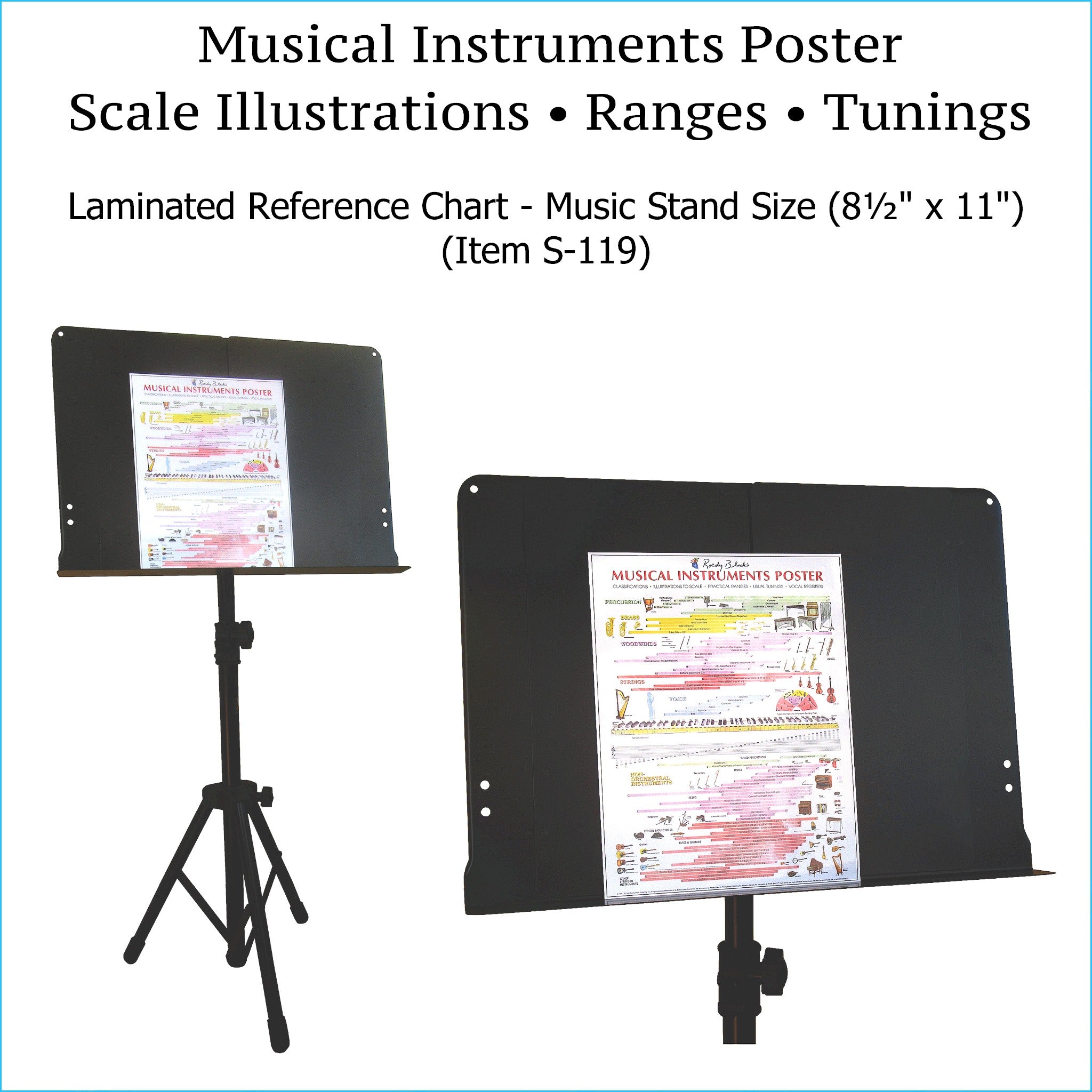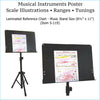Item S-119: Musical Instruments Poster. LAMINATED Music-Stand-Size Chart. Provides Info for Creating, Arranging, & Mixing. FREE SHIPPING – USA & Canada.
Your Visual Guide to Voice and Musical Instrument Pitch Ranges, Note Frequencies, Tuning Directions, Illustrations to Scale
(Also Available as a Laminated Wall Chart, 19" x 27")
The Musical Instruments Poster provides information for creating, arranging, and mixing recorded or live music:
• Comparative pitch ranges of more than 70 popular musical instruments (by note and frequency)
• Six vocal registers (three male, three female) aligned for comparison with each other, and for reference by note and frequency: bass, baritone, tenor, contralto, mezzo-soprano, soprano
• Tuning directions for 23 of the most popular stringed instruments
• 88-note Great Staff (Grand Staff), with each note aligned to its frequency and piano key position
• Specific pitch frequencies (cycles per second or Hertz) for all 88 notes
• Instrument families classified, sub-classified (e.g. percussion, brass, woodwinds, strings, etc.), and illustrated to the same scale
Equalization (EQ) and Range Guide for Sound Mixing, Arranging, and Songwriting
If you arrange, record, or mix music (home recordings, live music, or studio recordings), you are aware of the importance of equalization (EQ). To do it accurately, you need to know the frequencies (number of cycles per second) of the notes associated with the pitch ranges of each musical instrument and each voice range.
Each musical instrument and vocal register has a different range. The Musical Instruments Poster displays the frequency (number of vibrations per second, or Hertz) for each note playable on each instrument, including the various human vocal registers.
Sometimes you may use a multi-octave electronic instrument such as a synthesizer to replicate the sound of some other instrument, one you don’t normally play, such as a bass clarinet or mandolin. That means you need to take care not to play outside the unfamiliar instrument’s natural range. The Musical Instruments Poster shows which notes (referenced to an 88-key piano)—and which corresponding frequencies—define the natural ranges of most popular instruments. So, even if you have never played the instrument you are emulating with your electronic keyboard, you can at least make sure you’re playing exclusively within the emulated instrument’s natural range.
Tuning Directions for 23 Popular Stringed Instruments
The Musical Instruments Poster provides tuning information for the orchestral stringed instrument family (violin, viola, cello, double bass) and for the orchestral harp.
As well, the poster shows how to tune a variety of folk and popular instruments, such as the guitar, sitar, banjo, pedal steel guitar, and Appalachian dulcimer. The notes corresponding to the open pitch of each string are displayed on each instrument’s “range bar.”
The Musical Instruments Poster also identifies special tuning relationships. For example, the violin and the mandolin are normally tuned identically.
Ranges of Musical Instruments and Human Voices
The poster shows the pitch ranges for more than 70 instruments in all (see the full list below). It also displays the practical ranges of human voices (vocal registers) for bass, baritone, tenor, contralto, mezzo-soprano, and soprano voices.
A horizontal bar shows the range of each musical instrument and vocal register. The left end of each bar, representing the lowest note normally playable on a given instrument, aligns vertically with its corresponding key on the piano. The right end of each bar, representing the highest note normally playable, aligns with its corresponding piano key. (For some instruments, some musicians are able to play higher and lower notes than those displayed on the Musical Instruments Poster. This also applies to vocal ranges.) Each end of each range bar displays the name of the note aligned with the respective piano keys.
The 88-key piano keyboard displayed across the middle of the poster visually aligns with the range bars of all the instruments and voices. The left and right ends of each instrument’s range bar align exactly with their corresponding piano keys.
Just below the piano keyboard is the Great Staff (or Grand Staff). It shows the pitches of all 88 piano notes, aligned directly beneath each corresponding key of the piano keyboard. This alignment extends to the uppermost and lowermost notes of the ranges of all musical instruments (and vocal registers) on the poster.
List of Instruments and Voices Featured on the Musical Instruments Poster
The upper half of the Musical Instruments Poster shows all the instruments of the symphony orchestra, and their ranges:
ORCHESTRAL INSTRUMENTS
Tuned Percussion
• Xylophone
• Celesta
• Lyra Glockenspiel
• Orchestral Glockenspiel
• Tubular Bells (Chimes)
• Vibraphone
• Marimba
• Timpani (Kettledrums)
Brass
• Trumpet
• Cornet
• Flugelhorn
• French Horn
• Tenor Trombone
• Bass Trombone
• Euphonium
• Tuba
Woodwinds
• Piccolo
• Flute
• Alto Flute
• Oboe
• English Horn (Cor Anglais)
• Clarinet
• Bass Clarinet
• Bassoon
• Contrabassoon
• Soprano Saxophone
• Alto Saxophone
• Tenor Saxophone
• Baritone Saxophone
Strings
• Violin
• Viola
• Cello
• Double Bass
• Harp
• Piano
HUMAN VOICES
Female
• Soprano
• Mezzo-Soprano
• Contralto (Alto)
Male
• Tenor
• Baritone
• Bass
The lower half of the poster shows a variety of popular non-orchestral instruments:
NON-ORCHESTRAL INSTRUMENTS
Tuned Percussion
• Jew's Harp (Jaw Harp)
• Steel Drums
• Mbira (Thumb Piano)
Winds
• Pan Pipes
• Whistling
• Tin Whistle (Penny Whistle)
• Soprano (Descant) Recorder
• Alto (Treble) Recorder
• Tenor Recorder
• Bass Recorder
• Organ
• Harmonica
• Concertina (English Type)
• Piano Accordion
• Melodeon (Button Accordion)
• Harmonium
• Melodica
• Uilleann (Irish) Pipes
• Highland (Scottish) Pipes
• Northumbrian (English) Pipes
Strings
• Zither
• Pedal Steel Guitar
• Appalachian Dulcimer
• Hammered Dulcimer
• Autoharp
• Mandolin
• Balalaika
• P’i-p’a
• Sitar
• Lute
• Bouzouki
• Banjo
• Guitar (Various Types)
• Ukulele
• Electric Bass
• Harpsichord
• Celtic (Irish) Harp
• Hurdy Gurdy (French Type)
Color-coded Range Bars and Scaled Illustrations
Color-coded range bars identify instrument families:
• Grey-green bars show tuned percussion instrument ranges
• Yellow bars show brass instrument ranges
• Purple bars show woodwind instrument ranges
• Red bars show stringed instrument ranges
• Blue bars show human vocal ranges
Except in a few cases (noted on the poster), each instrument is illustrated at 1/30 scale. This includes a 1/30-scale silhouette of a person, so you can compare the size of any instrument relative to the size of a person. As well, there is a diagram of a typical symphony orchestra seating plan.
Product Details
Laminated Reference Chart, Music Stand or Desk Size Publisher: Roedy Black Publishing ISBN-13: 978-1-897311-43-1ISBN-10: 1-897311-43-5 Chart Dimensions: 8.5" x 11" (22 cm x 28 cm) Finish: Laminated, both sides
Reviews of the Musical Instruments Poster
Once you have a close look at the clever way it's structured, the Musical Instruments Poster has a lot more practical information on it than first meets the eye. Wayne Chase has done a superb job of displaying intelligent and instructive material ... yet the whole effect is entertaining.
—Bill Tully, Preston, ID
[Wayne Chase] has picked all the right information to put on these posters ... I find all of them very practical, both for me and the music classes I teach at night school. Especially the Musical Instruments Poster.
—Charles Noga, Scarborough, ON
The members of my choir find the Musical Instruments Poster most helpful. They have a better understanding of where their individual voices fit into the sound of the whole choir.
—Jose Amado, Fresno, CA
The Musical Instruments Poster is a particularly effective in inspiring the imagination of my students, some of whom thought they had no music in them. It has sparked many lively discussions about different aspects of music.
—L. Vanderhoek, Toronto, ON
[The Musical Instruments Poster] shows some very valuable insights when you can see all the alignments [of the instrument ranges].
—F. Girdler, Moncton, NB


